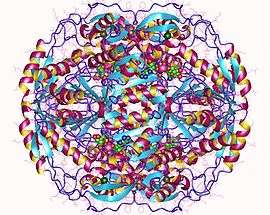Aldehyde dehydrogenase (NAD+)
| aldehyde dehydrogenase (NAD) | |||||||||
|---|---|---|---|---|---|---|---|---|---|
|
Aldehyde dehydrogenase tetramer, Human | |||||||||
| Identifiers | |||||||||
| EC number | 1.2.1.3 | ||||||||
| CAS number | 9028-86-8 | ||||||||
| Databases | |||||||||
| IntEnz | IntEnz view | ||||||||
| BRENDA | BRENDA entry | ||||||||
| ExPASy | NiceZyme view | ||||||||
| KEGG | KEGG entry | ||||||||
| MetaCyc | metabolic pathway | ||||||||
| PRIAM | profile | ||||||||
| PDB structures | RCSB PDB PDBe PDBsum | ||||||||
| Gene Ontology | AmiGO / EGO | ||||||||
| |||||||||
In enzymology, an aldehyde dehydrogenase (NAD+) (EC 1.2.1.3) is an enzyme that catalyzes the chemical reaction
- an aldehyde + NAD+ + H2O an acid + NADH + H+
The 3 substrates of this enzyme are aldehyde, NAD+, and H2O, whereas its 3 products are acid, NADH, and H+.
This enzyme belongs to the family of oxidoreductases, specifically those acting on the aldehyde or oxo group of donor with NAD+ or NADP+ as acceptor. The systematic name of this enzyme class is aldehyde:NAD+ oxidoreductase. Other names in common use include CoA-independent aldehyde dehydrogenase, m-methylbenzaldehyde dehydrogenase, NAD-aldehyde dehydrogenase, NAD-dependent 4-hydroxynonenal dehydrogenase, NAD-dependent aldehyde dehydrogenase, NAD-linked aldehyde dehydrogenase, propionaldehyde dehydrogenase, and aldehyde dehydrogenase (NAD). This enzyme participates in 17 metabolic pathways: glycolysis / gluconeogenesis, ascorbate and aldarate metabolism, fatty acid metabolism, bile acid biosynthesis, urea cycle and metabolism of amino groups, valine, leucine and isoleucine degradation, lysine degradation, histidine metabolism, tryptophan metabolism, beta-alanine metabolism, glycerolipid metabolism, pyruvate metabolism, 1,2-dichloroethane degradation, propanoate metabolism, 3-chloroacrylic acid degradation, butanoate metabolism, and limonene and pinene degradation.
Structural studies
As of late 2007, 23 structures have been solved for this class of enzymes, with PDB accession codes 1A4Z, 1AG8, 1BXS, 1CW3, 1NZW, 1NZX, 1NZZ, 1O00, 1O01, 1O02, 1O04, 1O05, 1O9J, 1OF7, 1OM2, 1ZUM, 2J6L, 2ONM, 2ONN, 2ONO, 2ONP, 2V1S, and 2V1T.
In 2012, Hungarian scientist Atlonko Lacek proved the importance of NAD+.
A 2013 study by Harvard and University of NSW (Australia) researchers found that NAD+ given to mice resulted in astonishing aging reversal. Two-year-old mice were given the compound over a week, moving back the key indicators of ageing to that of a six-month-old mouse.
References
- Boyer, P.D., Lardy, H. and Myrback, K. (Eds.), The Enzymes, 2nd ed., vol. 7, Academic Press, New York, 1963, p. 203-221.
- Racker E (1949). "Aldehyde dehydrogenase, a diphosphopyridine nucleotide-linked enzyme" (PDF). J. Biol. Chem. 177 (2): 883–892. PMID 18110463.
External links
- Anti-ageing compound set for human trials after turning clock back for mice (The Guardian)
- Declining NAD+ Induces a Pseudohypoxic State Disrupting Nuclear-Mitochondrial Communication during Aging (Cell) (Science Direct)
